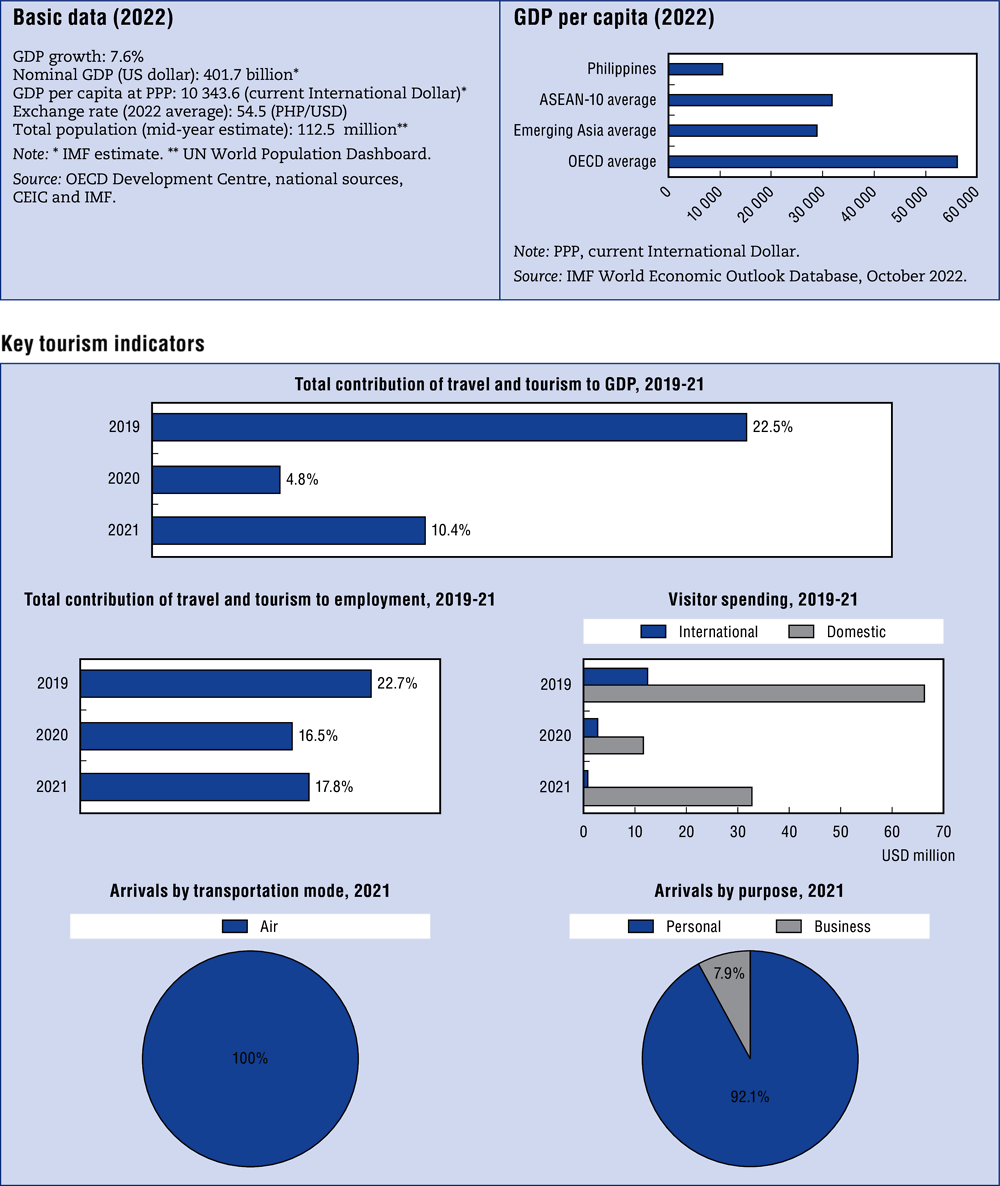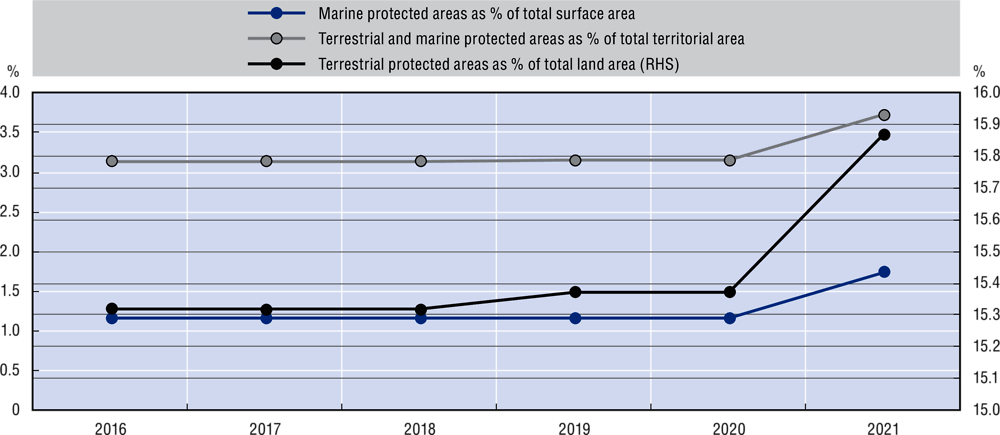The Philippines is endowed with a rich cultural heritage and natural landscapes from sandy beaches to densely forested mountains. Its tourism scene is characterised by a tropical clime and low prices, flavoured with fun and warm hospitality. Official policy of the Philippines declares tourism an indispensable element of its economy and seeks to promote the heritage of the Filipino people as well as sustainable tourism development. In 2019, the Philippines achieved the highest number of tourist arrivals ever, at 8.26 million (Department of Tourism, 2021). Unfortunately, this was followed by two years where the tourism sector was deeply curtailed by the COVID-19 pandemic and responses to it, but tourist arrivals exceeded government targets in 2022 and China’s abandonment of zero-COVID policy should help spur growth even further in 2023 and beyond. The World Travel and Tourism Council (WTTC) predicts that travel and tourism could contribute more than USD 155 billion to GDP in 2032, potentially creating nearly 3 million new jobs in the sector (WTTC, 2022b). This country note examines infrastructure challenges facing the sector as well as ecotourism development initiatives.
Economic Outlook for Southeast Asia, China and India 2023

Philippines

Source: OECD Development Centre based on data from UNWTO (2022), “Global and regional tourism performance” (database), UN World Tourism Organization, https://www.unwto.org/tourism-data/global-and-regional-tourism-performance (accessed on 26 November, 2022) and WTTC (2022a), “Philippines 2022 Annual Research: key highlights”, https://wttc.org/DesktopModules/MVC/FactSheets/pdf/704/184_20220613165812_Philippines_2022_.pdf.
Introduction
Current situation and policy challenges
Tourism policy objectives
From 2016-22, the Philippine government pursued several tourism objectives: transportation development, travel facilitation, attracting business investments, tourism promotion, and increased services standards. Transportation development is being pursued mainly through the development of airports. Nine airport construction or upgrade projects are expected to be completed in 2023. Streamlining the visa application process and introducing electronic visas will help stimulate inbound tourism. The tourism sector will also be bolstered by an improved business and investment environment. Developing and promoting new luxury products, or luxury versions of existing ones, can allow tourism businesses to cater to two distinct market segments and raise profits. Furthermore, developing a workforce able to communicate in additional languages will increase human resources capacity and service standards, as many foreign tourists to the Philippines come from countries with primary languages other than English, such as Korea, China and Japan. The national government will work with the local government units (LGUs) and relevant MSMEs to formulate 60 tourism plans per year, each catering to specific local needs.
Airport infrastructure
A new terminal was opened recently at Clark International Airport, north of Manila, with the aim of welcoming more tourists and flights into the Philippines and of improving passenger comfort. The new terminal expands passenger capacity to 8 million per year (Egis, 2021) and further expansion of the airport is expected to increase passenger capacity to 12.2 million per year and ultimately create 150 000 jobs, with multiplier effects on other activities (Rosario, 2022). Similar expansion programmes are expected at other domestic and international airports to stimulate the economy (Rosario, 2022).
The Philippine government’s “Build! Build! Build!” programme is helpful for reviewing the existing capacity of airports in terms of facilities and possible expansion to accommodate bigger aircraft and more traffic (Southeast Asia Infrastructure, 2022). Further oversight by the government should be a priority, together with rehabilitation of airports throughout the country, including in and around Manila. Airport projects to ramp up capacity are crucial for the Philippines to be a competitive destination.
Ecotourism and protection of the environment
The top tourist destinations in the Philippines are nature-based, so authorities have taken conscious efforts to protect the Philippines’ natural environment through the implementation of sustainable practices embedded in ecotourism for both ecological reasons and to preserve the economic viability of these sites. The previous government showed its willingness to close the island of Boracay to tourists for six months in 2018. This drastic step aimed to clean up the island’s beaches and refresh its fragile ecosystem, which had been affected by trash, pollution and non-compliant disposal of sewage by established businesses.
Among the many sites where ecotourism is popular, the islands of Bohol, Cebu and Palawan face a similar situation. Locals and environmentalists are deeply concerned about the effects on island ecosystems of the continuous influx of tourists and improper waste disposal. Existing permit requirements and regulations are meant to ensure that the environment is protected. These measures include the Clean Air Act; the Clean Water Act; the Hazardous Waste Law; the Ecological Solid Waste Management Act; and Presidential Decree No. 1586 on the establishment of an environmental impact system. The country’s efforts in conserving the environment can be seen in an increase in the amount of both terrestrial and marine area designated as protected in 2021 (Figure 5.2).
Figure 5.2. Philippines bolsters conservation in 2021
One of the first policies to promote ecotourism was initiated in 1999 via Executive Order No. 111, which outlined the establishment of a National Steering Committee and Regional Ecotourism Committee to oversee the development and management of ecotourism attractions and leisure facilities (Official Gazette, 1999). Moreover, non-governmental organisations (NGOs) and volunteer groups carry out regular beach clean-up activities, and many attractions conduct brief education sessions on respecting nature and wildlife. Even with these measures in place, enhanced transparency and enforcement are needed to ensure compliance. In Davao, local authorities impose a fine for trekkers who deviate from the prescribed route and leave trash on their trail (Tagoranao and Gamon, 2019). A combination of specifying approved behaviour and similar fines could help preserve the environments of other protected areas.
Consumer demand also plays a role in the decision to pursue environmental protection standards. More travellers are now considering their environmental impacts and seeking to limit them as much as possible. The Department of Tourism offers an Environmental Compliance Certificate (ECC) to hotels and resorts and has incorporated environmental standards into the star ratings of these establishments, though better enforcement is needed to ensure compliance with ECC standards. The ECC initiative provides a signal to these travellers that ECC-holding establishments are choices that better align with their concerns, while the incorporation of environmental standards into hotel ratings helps present hotels and resorts with more environmentally friendly practices as better choices to those travellers who care less, or do not care at all. Furthermore, certification programmes with limited validity could be implemented for tour operators who conduct wildlife tours or scuba diving in protected areas, increasing the attractiveness of these experiences to those with environmental concerns.
Business conditions and development projects
The Philippines has an open business environment for tourism establishments. The Tourism Act of 2009, recognises tourism as a vital part of the Philippine economy, authorises the Tourism Infrastructure and Enterprise Zone authority (TIEZA) authority to grant incentives to tourist enterprises in designated zones, including tax holidays, tariff and duty exemptions to reduce operating costs. The government is also undertaking projects to attract tourists to the Philippines and make their stays more enjoyable so that the benefits of the business environment can be fully realised.
Authorities are working to increase the efficiency of the travel experience to the Philippines through the Travel Facilitation Initiative, which calls for as streamlined visa process and the issuance of electronic visas. The development of rest and information centres as well as a comprehensive Tourist Lifecycle App will enhance the travel and transportation experience within the country. A total of ten Tourist Rest Areas (TRAs) are currently planned, and they will be distributed among Luzon, Visayas, and Mindanao. To improve accessibility within the country, authorities are considering establishing “hop-on, hop-off” buses in key tourist destinations. These projects are considered high priority, as the Department of Tourism (DOT) seeks to distinguish the Philippines as a unique destination from its ASEAN neighbours and make up for a later removal of entry restrictions than in other ASEAN countries.
Ground was broken on two of the TRAs in Carcar City, Cebu on 17 December 2022. The Philippine Experience caravan tours will immerse tourists in a region of their choice. Inspired by an earlier programme in Cebu, Philippine Experience tours are expected to be operation nationwide during the first quarter of 2023. The Philippine government is also enlisting Filipinos abroad and Overseas Foreign Workers (OFWs) in their tourism recovery effort. They are able to sponsor a tourist through the Department of Tourism’s Bisita Be My Guest (BBMG) programme, which features helpful information, discounts, and chances to win prizes for both the sponsored tourist and the sponsor.
References
Department of Tourism (2021), “2019 International arrivals exceed target with 8.26 million visitors to the Philippines”, 22 February 2021, https://beta.tourism.gov.ph/news_and_updates/2019-international-arrivals-exceed-target-with-8-26-million-visitors-to-the-philippines/.
Egis (2021), “Doubling the capacity of Clark International Airport”, Egis Group, https://www.egis-group.com/projects/clark-airport.
IMF (2022), “World Economic Outlook Database” (accessed October 2022).
Official Gazette (1999), “Establishing the guidelines for ecotourism development in the Philippines”, Executive Order No. 111, s. 1999, President of the Philippines, 17 June 1999, https://www.officialgazette.gov.ph/1999/06/17/executive-order-no-111-s-1999/.
Reuters (2020), “Philippine consortium drops $2 billion airport project”, 7 July 2020, https://www.reuters.com/article/us-philippines-infrastructure-airport-idUSKBN2481O4.
Rosario, M.D.D. (2022), “Public-private partnership crucial for infra dev’t: PBBM”, Philippine News Agency, 28 September 2022, https://www.pna.gov.ph/articles/1184841.
Southeast Asia Infrastructure (2022), “CAAP requests bids to expand four airports in the Philippines”, 27 July 2022, https://southeastasiainfra.com/caap-requests-bids-to-expand-four-airports-in-the-philippines/.
Tagoranao, M. and A. Gamon (2019), “Relevance of Philippine policies for Muslim-friendly ecotourism management in adapting the climate change challenges”, IOP Conference Series: Earth and Environmental Science, Vol. 348, https://iopscience.iop.org/article/10.1088/1755-1315/348/1/012012, pp. 1- 5.
UNWTO (2022), “Global and regional tourism performance” (database), UN World Tourism Organization, https://www.unwto.org/tourism-data/global-and-regional-tourism-performance (accessed on 26 November 2022).
WTTC (2022a), “Philippines 2022 Annual Research: key highlights”, https://wttc.org/DesktopModules/MVC/FactSheets/pdf/704/184_20220613165812_Philippines_2022_.pdf
WTTC (2022b), “WTTC’s latest Economic Impact Report reveals significant recovery in the Philippines travel & tourism sector in 2021”, World Travel and Tourism Council, 20 April 2022, https://wttc.org/news-article/wttcs-latest-economic-impact-report-reveals-significant-recovery-in-the-philippines-travel-and-tourism-sector-in-2021.
